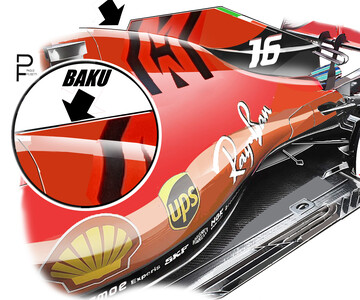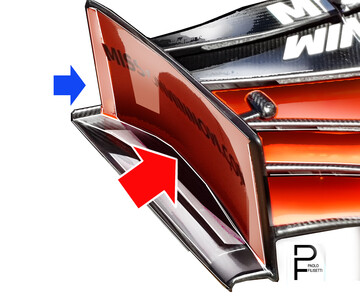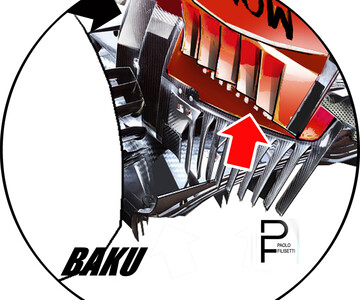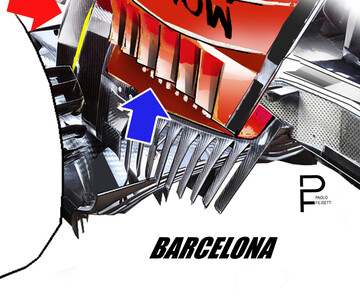As is tradition, all teams consider Barcelona as the first race in which not only is it easier to introduce substantial developments to the cars given the logistical advantage, but also where the results of the previous test are conclusive.
In fact, the Montmelò track includes long straights, high-speed bends, and tight curves where traction is essential. In essence, it is correct to say that a car that performs well on this track can be considered competitive on most of the circuits on the calendar. Ferrari, after anticipating in Baku most of the package of developments that were originally planned for this race, has completed the first evolution of the SF90. It has done this by introducing new elements at the level of wings and shark fin on the engine cover, and even brinigng forward its new power unit by two GPs.
Just as we commented on the effort made to bring the package planned for Spain in Azerbaijan, it is equally important to underline how much went into the production effort and above all, the effort surrounding the power unit was titanic, as confirmed by team principal and technical director, Mattia Binotto.
The developments brought to Barcelona have increased the efficiency of the car, reducing some turbulence generated by the upper edge of the fin above the engine cover, while also improving the efficiency of the rear wing. This one had a new flat profile but above all the endplates, in which the section of the slits was increased at the level of the trailing edge. The back fringes have also increased, now consisting of seven elements compared to the six in the version seen in Azerbaijan. Even the front wing, while maintaining the basic concept based on the outwash (deviation of the flows outside the front wheels), presented new endplates, characterized by an accentuated curvature towards the outside, but also by the inclination with respect to the vertical axis, which increased the section of the lateral channel.
All the modifications tested on both cars were contextual to the adoption of brake drums with larger slits to increase heat dissipation and produce an improvement in the behaviour of the car, even in twisty sections. Although in reality, in the third sector of the track, the SF90 showed a serious lack of mechanical grip, suffering from clear understeer.
A separate chapter is reserved for the power unit, which was developed with particular emphasis on combustion. In conjunction with its introduction was a specific new fuel and lubricant. Both allow, beyond the best combustion produced by the first, an effective reduction of the heat produced in the engine heads, thus ensuring a reduction in friction, improving the energy balance, and reducing consumption as well as being a further guarantee of reliability.
Even Mercedes, despite the advantage in the standings accumulated in the first four races, has spared no efforts in the evolution of the W10's aerodynamics. The car of the Brackley based team has undergone constant development in the previous GPs, often based on small but incisive changes. Here, we could say, they opposed the "firepower" that Ferrari has deployed, also introducing the evolution of the 064 power unit, along with an aerodynamic development that optimizes the car's efficiency.
Specifically, the changes concerned the turning vanes at the height of the horizontal "boomerangs", now no longer separated, but joined together, and the addition of a profile above the rear-view mirrors, which also acts as their support. These changes are not extensive, but they are relevant in increasing, in the first case, the deviation of the air flow that feeds the diffuser and optimize those that lap the sides.
The new version of the mirrors, on the other hand, allows a downward deviation (downwash) of the flow, substantially increasing the portion of that directed towards the air ducts. In reality, they have been used in free practice, and although there has been no formal complaint, nor decision by the FIA stewards, they were removed for Saturday. The rumour that raised in the paddock was related to the strong similarity of these elements, especially as regards to the added upper profile, to the ones that introduced precisely in Spain of last year on the SF71H and then banned by the FIA. An aerodynamic effect was considered as their primary purpose, rather than being a structural element.
Last but not least is Red Bull, which has modified the turning vanes, giving them a double series of overlapping boomerangs. In addition to this, the lower "scimitars" are again designed and increased in number, for better flow management, diverting it outwards, in front of the bottom edge. The car designed by Adrian Newey, seemed more powerful in a straight line than in the previous races and maintained a very good handling and grip in the twisty sections. In Montecarlo, it will certainly be a very competitive opponent for Mercedes and Ferrari, even in qualifying.
Mercedes W10: Barge boards and rearview mirrors
In the drawing we can see how the mirror supports have been modified, now with an upper profile that creates a blow with the lower fairing. (Red Arrow). This element generates a downward deviation of the air flow, channelling it towards the air intakes. Also the “boomerangs” of the deflectors have been modified for a better channelling of the air flow in this area (blue arrows), and its separation in the portion that flows at the sides of the sidepods and in a second portion diverted outside
Ferrari SF90: Shorter shark fin
The trailing edge of the vertical fin on the engine hood, now has a diagonal cut, interrupting the horizontal profile that previously started at the point of upper tangency. This modification has the purpose of reducing the drag and at the same time to divert the air flow towards the area of the T-wing, increasing the downforce. Furthermore, the turbulence that the fin in some conditions generated towards the rear wing is now reduced.
Ferrari SF90: Front wing evolution
Keeping the concept of the front wing based on the out wash, the endplates have been modified, showing an evident curvature towards the outside and an inclination with respect to the vertical axle that increases the section of the side channels. This is an optimization of the version adopted since the launch.
Ferrari SF90 rear wing endplates Baku–Barcelona comparison
In addition to the adoption of a flat and slightly reduced wing profile, the endplates differed from those introduced in Baku, as the section of vertical slits was increased at the level of the trailing edge. Also a greater number of rear fringes were introduced now counting seven distinct elements, compared to the previous six.
Red Bull RB15: Turning vanes development
The Milton Keynes team's car presented a radical evolution of the “boomerangs” now consisting of two superimposed elements. It was also increased the number, and modified the profile of the lower scimitars. These are changes aimed at increasing the "efficiency of the floor, increasing the downforce it produces.

 1
1
































Replies (1)
Login to replycalle.itw
Posts: 8,527
An interesting piece for sure. And it's also about When to bring certain upgrades. Bringing a PU upgrade to Barcelona seems very desperate to me.